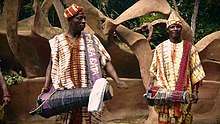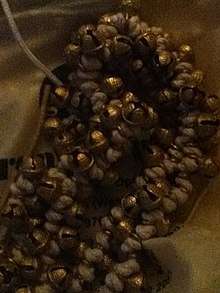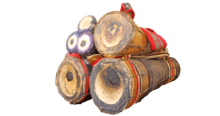Batá drum
A Batá drum is a double-headed drum shaped like an hourglass with one end larger than the other. The percussion instrument is used primarily for the use of religious or semi-religious purposes for and originates from the native culture land of the Yoruba and the Igbo, located in Nigeria, as well as, but not of origin, by worshippers of Santería in Cuba, Puerto Rico, and in the United States. The Batá drum's popular functions are entertainment and to convey messages. Its early function was as a drum of different gods, drum of royalty, drum of ancestors and drum of politicians. Batá drum impacted on all spheres of life in Yoruba land.[1]
 Batá drums (from left: Okónkolo, Iyá, Itótele) (photo courtesy Harold Muñiz) | |
| Percussion instrument | |
|---|---|
| Classification | Percussion |
| Hornbostel–Sachs classification | 211.242.12 (Individual double-skin hourglass-shaped drums, both heads played) |
| Musicians | |
| Irakere, Julito Collazo | |
History

Several different types of drums have existed throughout the world. Occasionally, natives from cultures which the drums originate, as in the case of the Yorùbá, used the drums for religious ceremonies and, since their introduction in Cuba in the 1820s, have come to be an understood and important part of the perceived culture of the southwestern Nigerian people.
The drum dates back roughly 500 years, and is believed to have been introduced by a Yoruba king named Shangó el rey del tambor. Despite the previous long history, awareness of the instrument didn't spread until the 1800s slave-trade in which close to 300,000 Africans were brought to Cuba. The religion and beliefs the Yorùbá brought with them eventually became the basis for what is known as Lukumí (or Santería in Cuba). This religion spawned the creation of the first "sacred" Batá in Cuba around 1830 by a Yorùbá named Añabi.
The Batá slowly became inducted into the Cuban culture after a time, and began to take on more secular uses: they were first publicly performed in 1935 in a broadcast over Cuban radio for purposes of folklore music. Uses such as this have grown as knowledge of the instrument has spread; more and more musicians not currently practising Lukumí have used versions of the drums in recordings or performances. These "non-sacred" Batá drums are called aberínkula—profane Batá (see Sacred-profane dichotomy). Batá drums and rhythms have started to be used in other genres, most notably in Cuban timba, jazz and hip hop. In the 1970s, for instance, a mixture of Batá drums and Big Band called Son-Batá or Batá Rock became popular, a genre highly influenced by Irakere.
Skilled secular musicians made appearances in the United States throughout the twentieth century; the likes of Julito Collazo and helped the spreading of such mainstream uses in the context of Latin music.
The Lukumí and the Batá
The Lukumí (or commonly called santería) religion and Batá drums are closely associated. The drums are played simultaneously (often with a rattle or "atchere") to create polyrhythmic compositions, or "toques" during santería ceremonies. A ceremony with batá drums is generally known as a "toque," "tambor de santo," or "bembé," but ceremonies can also be accompanied by shaken gourd-rattle "chékere" (in English "shekere") ensembles (usually with tumbadora, also called conga drums).

There are estimated to be at least 140 different toques for the spirits (saints, or santos) and their different manifestations. There are two important "rhythm suites" that use the sacred batá drums. The first is called "Oru del Igbodu" (a liturgical set of rhythms), alternatively called "Oru Seco" (literally "Dry Oru", or a sequence of rhythms without vocals), which is usually played at the beginning of a "tambor de santo" that includes 23 standard rhythms for all the orishas. The selections of the second suite include within them the vocal part to be performed by a vocalist/chanter (akpwon) who engages those attending the ceremony in a call-and-response (African) style musical experience in which a ritual is acted out wherein an "initiate" (one who through the great spirit Añá is granted the ability to perfectly play the Batá drums) plays the new Batá set, and thereafter is introduced to the old Batá set. This is said to "transfer" (through the initiate) the spirit or Añá of the drums from the old set into the new set.
Certain long-standing rules and rituals govern the construction, handling, playing, and care of the sacred batá: traditionally only non-castrated male deer or goat hide was used—female goats along with bulls, cows, and sheep were considered unsuitable; also only an initiate was considered worthy to touch or play the batá as only they have undergone the full ritual of "receiving Añá" granting them the forces deemed necessary to play the drums. Also, before a ceremony, the drummers would wash themselves in omiero, a cleansing water, pray, and for some time abstain from sex.
Also traditionally in Cuba, in Havana the batá are rarely played after sundown, while in Matanzas toque ceremonies often begin at night. This apparent contradiction is not the only one reaching both adherents of Lukumí and others interested in African music, religion and culture. The Cuban style of playing the drums is similar, but in some musical contexts different rhythms may be used.
In the last few decades, the popularity of the batá drums has increased worldwide so significantly that they have begun to be produced in greater numbers both by large western drum companies and individual artisans in Africa using a variety of "non-traditional" materials even including fiberglass drums, some instrument builders preferring cow skins or even synthetic membranes, while some traditionalists may express disdain for this trend and insist upon strict orthodoxy (as others and newcomers embrace the unique tonal ranges of the drums purely for their abstract musical possibilities without observance of traditional rules and rituals). These seemingly conflicting points of view remain paradoxical within the musical "landscape", as has been the global evolution of the Indian Tabla, both families of percussion instruments finding application in often surprisingly diverse musical settings far from their roots, although batá perhaps having a closer religious affinity with Lukumí than tabla with Hinduism.
Those who practise Lukumí believe that certain sacred rhythms performed on the batá contain the levels of spiritual forces required to allow such impassioned ritual music to summon Orishas, who in turn inhabit or possess (more in the sense of angelic rather than demonic possession) one or more of the followers gathered for worship and/or participating in the ritual. Followers of Lukumí believe that Orishas are responsible for control of all natural and life-related forces, however the most-frequently stated primary purpose of the batá is simply for glorification of the deified Changó, also known as "The Great Spirit" or less ceremoniously as thunder and lightning. Hence such ceremonies and rituals are often performed for blessing important life transitions and events like weddings, relocations, passage to the afterlife, or other events and festivities.
Parts of the Batá
In Cuba, the batá consists of a set of three tapered cylinders of various sizes. Iyá, the largest, is referred to as "mother drum". Itótele, the middle one, and Okónkolo, the smallest, are called "father" and "baby", respectively. In Nigeria, there are five sizes of batá, which can be played either by hand, or using a leather play strap. In Matanzas, the older Batá lineages play with one hand and the sole of a shoe or other improvised strap. In Cuba, it is common to see the drums decorated with small bells and chimes, which are called Saworoide or "Saworo" in Yorubaland and Chaworoide or "Chaworo" in Cuba; such bells are attached to one or two "igbaju" leather straps for mounting on the Iya. The larger drum head is called the "enu", while the smaller is the "chacha".

In Yoruba land, Bata drum has different parts which are: 1) Igi Ilu: This is the wooden frame work of the drum. 2) Leather: This is the part of the drum that bring out the tone of the drum. There are two piles of leathers in a Bata drum. One is to bring out the tone of the drum, while the other is to cover the one that brings out the tone of the drum. 3) Egi Ilu: This helps to hold the leather firm to the wooden frame. it is usually constructed with the use of small bunch of thick brooms also known as Igbale gbaro. The brooms are curved to take the proper shape and size of the top and bottom of the wooden frame of the drum. After the sizes have been obtained, strong threads are used to tighten the buch of thick brooms. After that, pieces of cloths are used to cover the tighten brooms to beautify it. 4) Osan: This is made from thick leathers. This serves as the wire work of the drum. It helps in holding both the leather and Egi Ilu in place. 5) Iro: This is the black substance that is found on the surface of the leather of Bata drum. It primary purpose is to vary the tones from different faces of the drum. It is usually obtained from a tree. all the faces of bata have this substance apart from the face that is called Ako- this face gives the highest tone in the drum. 6) Bulala: This is also made of thick leather. it is used to play the drum. Nowadays, flexible plastics are being cut to look like leather bulala. This flexible plastics can also be used to play the drum. 7) Cowry: This is always inserted into Bata drums. People call it AYAN
References
- Bode Omojola, 1 April 2009: Yorùbá Bàtá Goes Global: Artists, Culture Brokers, and Fans (review), African Studies Review, Volume 52, Number 1, April 2009, pp. 216-217. Retrieved 28 December 2011.
- Mason, John (1992), Orin Orisa: Songs for Selected Heads, Brooklyn, NY: Yoruba Theological Archministry
- Amira, John, & Steven Cornelius (re-issued 1999), The Music Of Santería: Traditional Rhythms Of The Batá Drums: The Oru Del Igbodu, White Cliffs Media
- Ajayi, Omofolabo S. (1998), Yoruba Dance: The Semiotics of Movement and Body Attitude in a Nigerian Culture, Trenton, NJ: Africa World Press
- Debra, L. Klein (2007), Yoruba Bata Goes Global, University of Chicago Press, p. 166
- iPhone App that contains original Batá rhythms, simulates the call and response interaction and a free companion book with transcriptions: http://www.percussiontutor.com
- The Santeria Music Database, which provides a list of specific Batá rhythms and associated chants found on recordings: http://furius.ca/santeriadb